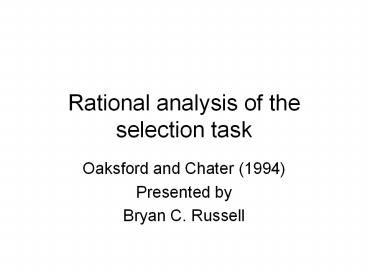Rational analysis of the selection task - PowerPoint PPT Presentation
Title:
Rational analysis of the selection task
Description:
Rule: if there is a vowel on one side, then there is an even number on the other ... Objective inquirer. Check the validity of the statement... Human performance ... – PowerPoint PPT presentation
Number of Views:58
Avg rating:3.0/5.0
Title: Rational analysis of the selection task
1
Rational analysis of the selection task
- Oaksford and Chater (1994)
- Presented by
- Bryan C. Russell
2
Wason selection task
- Rule if there is a vowel on one side, then there
is an even number on the other side
K
2
7
A
3
Last time
- Humans are stupid
- Cosmides et al.
- Social contract theory (i.e. innate ability to
detect cheaters) - Depends on perspective (enforcer or actor)
4
Outline
- Probabilistic account of Wason selection task
- Information-theoretic background
- Application to abstract selection task
- Application to thematic selection task
- Discussion
5
Another view of the task
- Let rule be if p then q
- Four types of cards
- (p,q), (not-p,q), (p,not-q), (not-p,not-q)
- Two hypotheses
- MD p,q are dependent (rule is true)
- MI p,q are independent (rule is false)
6
Assumptions
- We can assign probabilities to the cards
- Should reflect natural statistics of if p then
q statements in nature - P(p MD) P(p MI) a
- P(q not-p,MD) P(q not-p,MI) b
7
Card probabilities
8
Card probabilities
- Task Select card that maximally reduces
hypothesis uncertainty
9
Entropy/uncertainty
10
Entropy/uncertainty
11
Entropy/uncertainty
12
Another experiment
- Suppose you observe
- TTHTHHTHHHHTHHTHTHHT
13
Another experiment
- Suppose you observe
- TTHTHHTHHHHTHHTHTHHT
- HTHHTTHTHHTTTTTTTTTH
14
Another experiment
- Suppose you observe
- TTHTHHTHHHHTHHTHTHHT
- HTHHTTHTHHTTTTTTTTTH
15
Mutual information
16
Application to selection task
a Pr(p)
17
Application to selection task
a Pr(p)
18
Model behavior
19
Observations
- If Pr(q) is low, then choosing p card is
informative - If Pr(p) and Pr(q) is low, then choosing q card
is informative - If Pr(p) is high, then choosing not-q card is
informative - not-p card is not informative (results in zero
information) - P(MI) only scales information values
20
Model behavior
R
21
Rarity assumption
- For selection task, in humans Pr(p) and Pr(q) are
low - Expectation over region R
- choose p 0.76
- choose q 0.20
- choose not-q 0.09
- choose not-p 0
22
How do humans compare?
23
(No Transcript)
24
(No Transcript)
25
Analysis
- Both humans and model accounts for the following
information relationship - choose p gt choose q gt choose not-q gt choose not-p
26
Thematic selection task
- If a passenger form says ENTERING on one side
then the other side must include cholera
information
ENTERING not checked
cholera information
no cholera information
ENTERING checked
27
Rule types
- Obligations if action (p), then must condition
(q) - Permissions if condition (p), then may action (q)
28
Subject perspective for permission rule
- Enforcer
- Pretend you are an immigrant officer
- Actor
- Pretend you are a traveler
- Objective inquirer
- Check the validity of the statement
29
Human performance
- Obligation action (p) gt must condition (q)
- Permission condition (p) gt may action (q)
30
Utility-based model
- Focus on rule-use, not rule-testing
- Associate cost with turning over a card
31
Utility-based model
32
Performance of utility-based model
33
Andersons (1990) steps for rationality
- Specify precisely the goals of the cognitive
system - Develop a formal model of the environment to
which the system is adapted - Make minimal assumptions about computational
limitations
34
Andersons (1990) steps for rationality
- Derive the optimal behavior function given the
previous steps - Examine the empirical evidence to see whether the
predictions of the behavioral function are
confirmed - Rinse, lather, repeat, and refine the theory
35
Conclusions
- Bayesian approach more principled than other
accounts - Applies to both abstract and thematic versions of
the problem (and their variants) - Behavior is adapted to the environment and does
not necessarily follow logic/mathematic theory
36
Discussion questions
- Is the rarity assumption valid? How do we test
it? - Is the selection task representative of
accounting for rational thought? Is it
exhaustive? - How is this model realized?
- Does one learn explicitly the utility costs and
Pr(p)/Pr(q)?

